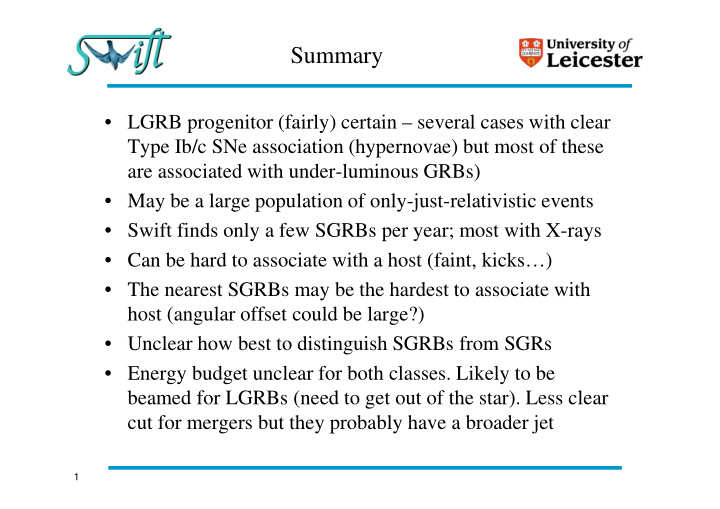



Summary • LGRB progenitor (fairly) certain – several cases with clear Type Ib/c SNe association (hypernovae) but most of these are associated with under-luminous GRBs) • May be a large population of only-just-relativistic events • Swift finds only a few SGRBs per year; most with X-rays • Can be hard to associate with a host (faint, kicks…) • The nearest SGRBs may be the hardest to associate with host (angular offset could be large?) • Unclear how best to distinguish SGRBs from SGRs • Energy budget unclear for both classes. Likely to be beamed for LGRBs (need to get out of the star). Less clear cut for mergers but they probably have a broader jet 1
GRB051103: an SGR Giant Flare? • Predicted R band magnitude at Pink – UV (GALEX) 3 days would be ~34 Blue – 21cm Radio (THINGS survey) Green – Optical (Digital Sky Survey) • Progenitor is a young neutron The green lines show the boundary of star, hence may expect to find: the error ellipse – Star formation – Supernova remnant – Massive star clusters • Most nearby events come from IPN (all-sky) – poorly localised 2
Summary • GRBs now a mature subject • Have redshifts for hundreds of GRBs (all extragalactic) • Despite this, many things are uncertain – Progenitors (at least some LGRBs are CCSNe but what else?) – Emission process (non-thermal, thermal…) – Total energy budget – Use of GRBs as probes (find hosts, SFR tracer, cosmology…) • In multi-messenger era how to maintain momentum? – Need a post-Swift mission with “reasonable” localisation error – Need wide-field search capability (snapshot vs. tiling) as some facilities such as A-LIGO will provide a large error box – What does the GW communitywant? May not be the same as the broader GRB community (high-z, low L, mergers…) 3
SVOM Satellite (France, China, Leicester) Follow-on from Swift: MXT ECLAIRS � better energy coverage, pointing strategy (anti-Sun) and lower trigger GRM energy range (4-300keV) Gamma Ray Monitor � Find nearby X-ray bright, low L GRBs (SN connection) and high-z GRBs (cosmology) PIM � Planned Phase B start in 2012/13 VHF Payload Interface Module Alert System � Launch hoped for 2016-2017 � New plan – mission may split into X Band two spacecraft (the “train”) 4
Lobster concept 5
Lobster concept These modules provide ~500 sq. deg each but design is very scalable. Mini-version will be proposed to ESA S-class call. 6
Recommend
More recommend